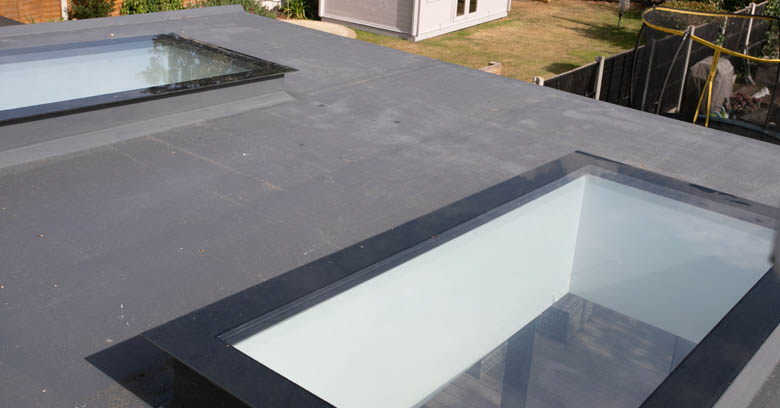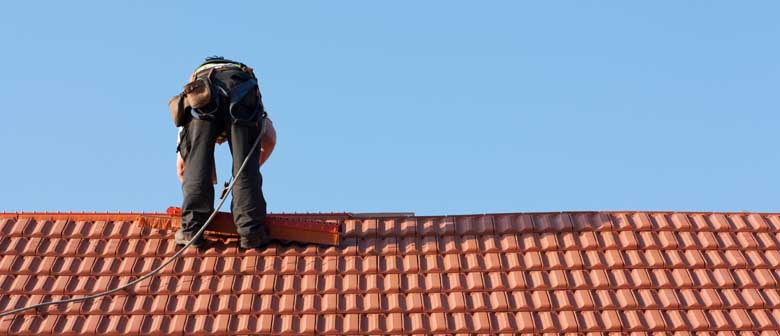One of the most important choices to make when planning a roof replacement is choosing between a flat roof or pitched roof. The type of roof you choose will decide several factors, such as which roofing materials you can use, the longevity of the roof and building regulations you will need to uphold.
A flat roof consists of one, continuous horizontal surface. Flat roofs are extremely cost-efficient and take less time to construct.
A pitched roof slopes downwards at either side which helps with drainage and ventilation.
Factors to consider when deciding between a flat roof or pitched roof include:
- Budget: Are there any limitations on how much you would like to spend?
- Materials: Is there a particular material that you want to use for the roof replacement?
- Lifespan: How long do you want your flat or pitched roof to last?
- Longevity: How long will you be living in your current home?
- Energy Efficiency: Is energy efficiency an important factor in your decision?
- Planning Permission: Will the flat or pitched roof require planning permission?
- Building Regulations: Which building regulations will apply depending on roof type?
Continue reading to learn more about the advantages and disadvantages of flat and pitched roofs.
Flat roofs

Flat roofs are more budget-friendly than pitched roofs because the materials used to construct them tend to be more affordable, such as roofing felt and EPDM membrane.
They often only take between two and three days for roofers to complete and can be converted to a roof terrace or balcony, giving you more outdoor living space (usually subject to planning permission).
If you opt for a flat roof, it’s important to look out for standing water gathering on the surface as this can lead to issues such as water leakages and roof sagging. Due to this, flat roofs tend to have a shorter lifespan than pitched roofs.
Should I get a flat roof?
| Advantages | Disadvantages |
| Highly cost-effective to construct or repair. | Standing water can gather on the roof’s surface which can lead to issues such as a sagging roof. |
| It only takes around two to three days to complete a full flat roof replacement. | Due to the lack of drainage, water leakages can occur. |
| Owners can use the top of the roof as an outdoor terrace or balcony. | A shorter lifespan of around 20 years due to the quality and durability of materials. |
| Repair costs are often lower due to the materials used in the original construction. | As the surface of the roof is flat, debris and dirt can build up over time. |
| Extremely easy to clean and maintain as owners can stand on the roof for support. | There is only a certain number of roofing materials available as some aren’t suited to flat roofs. |
Pitched roofs

Pitched roofs are extremely durable and can withstand even the most inhospitable of weather conditions due to the materials they’re made from and the sturdy foundations of the roof.
A large lifespan of between 40 to 100 years means that although pitched roofs are more expensive to construct, they tend to last longer than the flat roof alternative.
One of the downsides of pitched roofs is that they take longer to construct due to needing more materials to complete the job, which can also lead to higher maintenance costs.
Should I get a pitched roof?
| Advantages | Disadvantages |
| Extremely durable and capable of withstanding adverse weather conditions. | More expensive than flat roofs due to the materials used. |
| The shape of the roof provides an excellent level of ventilation and improved thermal efficiency. | Takes between one and two weeks to construct. |
| Large lifespan of between 40 to 100 years. | Higher maintenance costs because of sloped roofs being difficult to access. |
| The potential of adding loft space to extend your living space. | Some structures are unable to support pitched roofs because of a lack of foundations. |
| Sloped roofs are very water-resistant which prevents water leakage from occurring. | May require planning permission if switching from a flat to pitched roof due to the increase in height. |
In summary, whether a flat or pitched roof is best for you will depend on your specific situation.
A flat roof is most likely the best choice if you’re working to a budget and looking for a roof which is extremely easy to clean and maintain.
On the other hand, a pitched roof will be the optimal option if you’re going to be staying in your home for the foreseeable future and want a roof with longevity and minimal repair costs.
If you’re wondering how the costs can differentiate between flat or pitched roofs, visit our new roof cost guide to compare the two.
Alternatively, for more information on both flat or pitched roof replacement, visit our roofing page for the latest insights and advice.
To get quotes from roofers near you – post a job now.